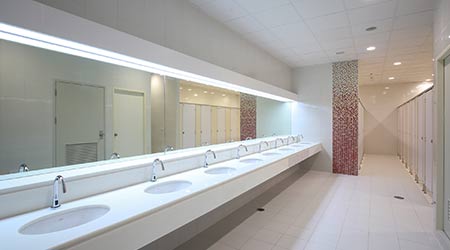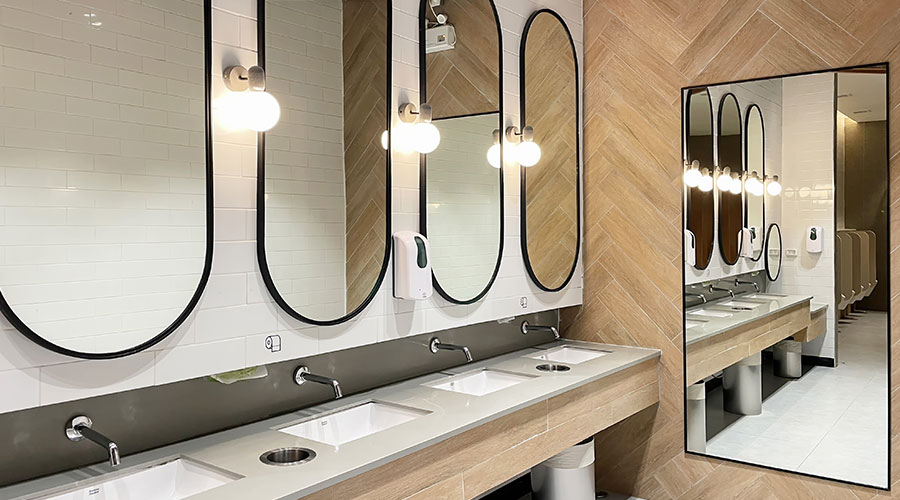Hygiene, Sustainability Key Considerations In Restroom Design
Sustainability and hygiene strategies can often be complementary if taken into consideration together during restroom design.
When it comes to hygiene, a point to keep in mind is that users with freshly washed hands may not want to touch a doorknob. One way to address that issue is to have restroom doors swing out. The alternative, Portis says, may be finding a lot of paper towels on the floor that people have used to pull the door open. Facility managers can put a wastebasket right next to the door, to let people drop paper towels after opening the door, Malarkey says. However, care should be taken with this option that the wastebasket does not obstruct proper clearance.
Portis says that facility managers go back and forth on paper towels versus air dryers, because “there’s a debate on which is more environmentally conscious and which is more sanitary.” While user preference should be considered, other factors to weigh include where the water will collect with hand dryers, and what that means for cleaning, safety, and hygiene. Putting paper towels directly next to the sink helps avoid dripping water on floors. Using a textured floor material is a good idea, for the water that winds up there anyway, Portis says. “You put water on a polished floor and you’ve got an ice rink,” he says.
Some new sink designs address the slip hazard by incorporating the soap dispenser and hand dryer directly, says Yrjanainen. The air flow of the dryer is angled down and some manufacturers have bowl designs with vents under the counter, “so you’re not blowing germs out of the sink bowl,” he says, and the drain catches any dripping water.
Malarkey has seen the blade-style hand dryer incorporated into the sink, but says “it will require some education, because people don’t know what to do.”
The desire for energy efficiency and sustainability is changing restroom design, too, and the demand is now coming from tenants. “Things that were buzzwords a few years back have become more and more the norm,” Ferendeci says. In the restroom, that means LED lighting, low-flow fixtures, and new maintenance methods, such as cleaning waterless urinals. “It’s a learning curve for everyone,” he says. Another efficiency is the two-stage toilet, with different flush settings for liquid or solid waste.
If a facility is thinking about installing energy- or water-efficient products, check with the local utility to see if the project would qualify for incentives. “Utilities are dying to give you those rebates,” Ferendeci says. Architects, engineers, and other third-party service providers may be able to help facility managers apply for rebates.
Other tips
When it comes to no-touch fixtures, many facility managers are finding that adding battery replacement to the cleaning staff’s checklist is not worth it, so hardwired systems are becoming more popular, despite greater initial expense. However, Yemi Babatunde, a building engineer for Akridge, a property management firm in Washington, says that he doesn’t see a problem with changing batteries, and that electric wiring systems fail more often, due to their proximity to water lines.
In designing a full floor of office space, it’s worthwhile to keep restrooms away from doors into offices because of “smells and sounds,” Malarkey says. On a single-tenant floor, placing two entries into the restroom, one on each side of the core, makes for greater efficiency and saves users steps, he says. But on a multi-tenant floor, that idea may not work due to security concerns.
David Lewellen is a freelance writer who covers facility issues.
Email comments and questions to edward.sullivan@tradepress.com.
Related Topics:














